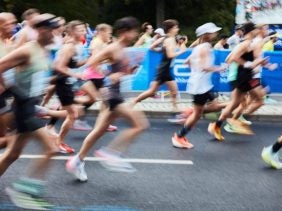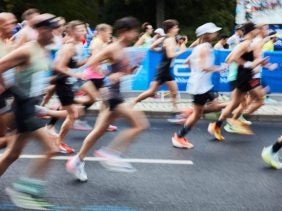9 Surprising Tips For a Fast Recovery After Your Run
 Justin Case
Justin Case
Successful runners who hit new personal records without regularly injuring themselves or suffering burnout are not only good runners, but usually also true recovery pros.
No matter how many kilometers you go, your body needs time for recovery after every run. The longer the run and the higher its intensity, the more important your recovery is.
The basis of any good post-run recovery is always your nutrition. We’ve compiled a list of the best supplements for athletes. Check out which is right for you!
Regeneration after running is roughly divided into 3 phases:
- First aid for your muscles immediately after your run
- Recovery measures, exercise, and lifestyle tips for the first few days post-run
- Your overall work-run-life-recovery balance
We have the best 3 tips for each phase of recovery!
Regeneration after running: First aid for your muscles
The first 45-60 minutes after your run are the most important. This is where you lay the groundwork for the best post-run recovery.
#1 Run your heart out. Even after the race.
After a fast run, continue to run at a recovery pace for about 5-10 minutes. After a slow but long run, that may mean going for a walk. The important thing is to keep moving. Moderate movement at the end of a workout promotes blood flow to the muscles and thus the breakdown of metabolic waste products such as lactate. The better this is broken down initially, the faster you regenerate after running.
# 2 Eat and drink
Yes, eat. And preferably as soon as you can. In the first 30 – 60 minutes after exercise, worn out muscles crave protein, and they can make use of it particularly efficiently, ideally when consumed in combination with carbohydrates.
To compensate for the loss of minerals, drink – preferably already during the run – our Recovery Aminos. It provides you with easily accessible BCAAs and L-glutamine. Thanks to the perfect concentration of nutrients, your body can utilize these minerals particularly quickly.
The only thing missing is protein. The best way to consume it is a matter of taste. Protein shakes directly after an intense workout are usually better tolerated than a snack or a real meal.
Vegan protein is always a good option if you want to avoid animal foods. If you prepare your shake at home, you can add a banana, nuts, and dates for an extra dose of potassium, healthy fats, and carbohydrates.
Our Vegan Protein Balls combine nuts, dates, and protein to a delicious and practical to-go snack that can be enjoyed between your cool-down and your shower.
#3 Go take a shower
And alternate between hot and cold water. The good-old alternating shower – unlike one that’s just cold – actually contributes to sustainable regeneration after running. The alternation of hot and cold promotes blood circulation, which contributes to efficient recovery. The better the blood supply to muscles, the better the removal of metabolic waste products and the transport of nutrients into them.
Bonus tip: Meditate! At first glance, it seems to have nothing to do with running or physiological regeneration, but at second glance it does quite a bit. Scientists know that meditation influences the central nervous system and has a direct impact on physical relaxation and performance.
Regeneration after running: The days after
In those first 48-72 hours after an intense run, your active and passive musculoskeletal system and your central nervous system are still absolutely in recovery mode. With these 3 habits, you can support them.
#1 Forget the cold plunge
If you dare to jump into ice-cold water (like a cold plunge or a nearby lake) immediately after exercise, you prevent the cellular damage caused by intensive training. That sounds good at first, and it also helps you to get fit again quickly. But in order to improve and benefit from supercompensation, you actually need this cellular damage.
So does an ice bath help with regeneration? If you need to be fit again as quickly as possible, absolutely. If you want to improve, it’s not the best solution for the long term.
#2 Sweat it out in the sauna
Heat baths, on the other hand, support immediate recovery after running by helping to lower muscle tone. If you go to the sauna after a strenuous run and feel heavy and your muscles working afterwards, it’s a sign that recovery is in full swing.
Regular sauna visits are not only good for your muscles, but can even make you faster – they increase the plasma volume in combination with proper endurance training.
Important: When taking heat baths, always compensate for the loss of fluids and minerals through sweat by drinking plenty of water.
#3 Roll out
With the fascia roller you support your body in regulating the tension state of the muscles and the transitions from muscles to tendon. This not only supports your muscles, but also lowers muscle tone and thus reduces the pull on the tendon.
Especially in monotonous running, active injury prevention is a non-negligible part of recovery on day 1 or 2 after the run. Here are our 5 favorite exercises with the fascia roller.
Regeneration after running: Lifestyle makes the difference
Taking the right recovery measures after a run is half the battle. You will recover even better if you also create the best conditions for good recovery in everyday life. This not only helps you to get fit again quickly, but also improves performance and health in all areas of life.
# 1 Power up your diet
Balanced nutrition is the be-all and end-all for top performance. Runners have special nutritional requirements: they need to fill their carbohydrate stores, give their muscles sufficient protein, and ideally get enough omega-3 to omega-6 fatty acids to prevent inflammation. In addition, zinc, magnesium, sodium, potassium, calcium, and of course all vitamins are important.
You can only regenerate optimally if you aren’t in a deficiency. To eat consciously in everyday life is in a way regeneration, training, and wellness treatment in one.
# 2 Sleep helps
In addition to nutrition, regular and sufficient sleep is also important. During the night, the most important regeneration activities take place in the entire body. Especially during intensive training, regular sleep and wake-up times support your body in regeneration. How much sleep athletes need varies from person to person. A good guideline is 6-8 hours. You may be tired when you wake up, but you should feel refreshed.
Read more: How to sleep well: 8 tips for a good night’s sleep!?
# 3 Strength and flexibility support your muscles
Compared to general fitness training, running puts a very monotonous strain on the musculoskeletal system. Strength training for runners is therefore essential to prevent muscular imbalances. The healthier your entire musculoskeletal system is, the better your movement quality and the load on the muscles.
Therefore, in addition to strength training, incorporate regular mobility & stretching exercises for runners.
More things to know from foodspring:
- Muscle recovery after your workout: 6 regeneration rules
- Why active recovery matters: Get moving on your rest days!
- Sleep, weight loss, and muscle gain: How are they connected?
- What to eat on rest days: 6 tips to maximize recovery
- 3 Meal Planning Tips for Vegan Athletes
Sources for this article
We at foodspring use only high-quality sources, including peer-reviewed studies, to support the facts within our articles. Read our editorial policy to learn more about how we fact-check and keep our content accurate, reliable, and trustworthy.

































